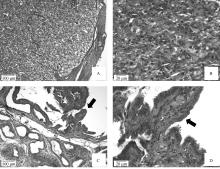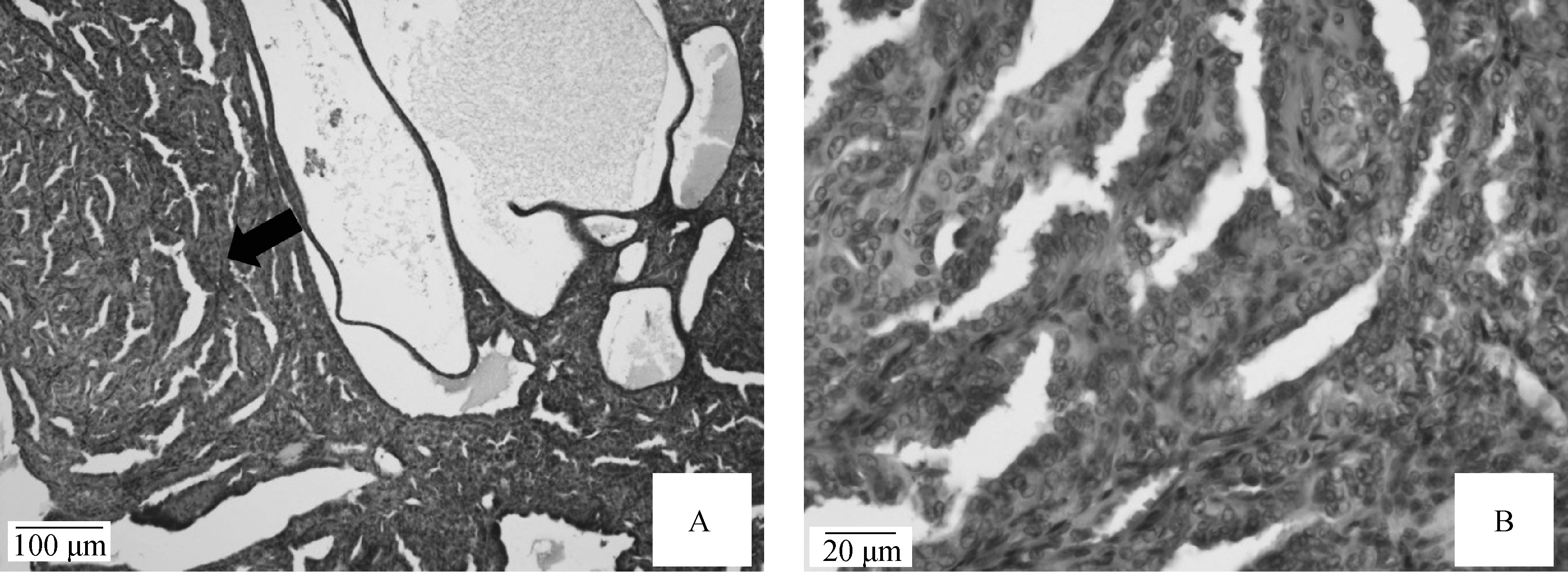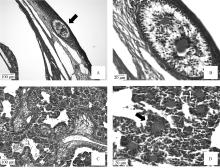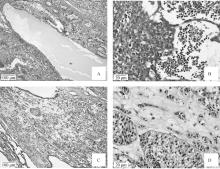





Acta Veterinaria et Zootechnica Sinica ›› 2025, Vol. 56 ›› Issue (5): 2393-2402.doi: 10.11843/j.issn.0366-6964.2025.05.036
• Basic Veterinary Medicine • Previous Articles Next Articles
LI Xueyuan( ), YANG Lifeng*(
), YANG Lifeng*( ), ZHAO Deming
), ZHAO Deming
Received:2024-06-28
Online:2025-05-23
Published:2025-05-27
Contact:
YANG Lifeng
E-mail:lixueyuan0720@163.com;yanglf@cau.edu.cn
CLC Number:
LI Xueyuan, YANG Lifeng, ZHAO Deming. Pathologic Diagnosis and Analysis of Ovarian Tumors in Dogs[J]. Acta Veterinaria et Zootechnica Sinica, 2025, 56(5): 2393-2402.
Table 1
Classification of ovarian tumors in dogs"
| 犬卵巢肿瘤分类Classification of ovarian tumors | |
| 上皮性肿瘤(Epithelial tumors) | |
| 卵巢腺瘤 (Adenomas of the ovary) | 乳头状腺瘤(Papillary adenoma) |
| 囊腺瘤(Cystadenoma) | |
| 卵巢网腺瘤(Cystadenoma of the rete ovarii) | |
| 卵巢癌 (Carcinomas of the ovary) | 乳头状腺癌(Papillary adenocarcinoma) |
| 囊腺癌(Cystadenocarcinoma) | |
| 性索间质瘤(Sex cord stromal tumors) | |
| 颗粒细胞瘤(Granulosa cell tumor) | |
| 卵泡膜细胞瘤(Thecoma) | |
| 黄体瘤(Luteoma) | |
| 颗粒-膜细胞瘤(Granulosa-theca cell tumors)、雄激素母细胞瘤(Androblastoma)、肾母细胞瘤(Arrhenoblastoma)、间质腺瘤(Interstitial gland tumor) | |
| 生殖细胞肿瘤(Germ cell tumors) | |
| 无性细胞瘤(Dysgerminoma) | |
| 畸胎瘤(Teratoma) | |
| 其他肿瘤(Other Tumors) | |
| 混合瘤(Mixed tumors) | 性腺母细胞瘤(Gonadoblastoma) |
| 混合性缪勒氏瘤(Mixed mullerian tumor) | |
| 转移性非卵巢肿瘤(Metastatic non-ovarian cancer) | |

Fig. 1
Papillary adenomas of the ovary A. The boundaries between the papillary adenoma of the ovary and the surrounding normal ovarian tissue are well defined (arrow), and a distinct envelope is visible around the tumor (100×); B. Under high magnification, the mass is seen to consist of arboriform papillae projecting into the lumen of cystic cavities, and the tumor cells are arranged on dendritic trabeculae (arrows) (400×)"


Fig. 2
Papillary carcinoma of the ovary A. Fibrovascular tissue is seen in luteal cysts (100×); B. Well-vascularized glandular luteal cells (400×); C. Papillary carcinoma of the ovary with ill-defined borders and ruptured cystic cavity, and tumor tissue is visible as arboriform papillae (arrow) (100×); D. Tumor cells irregularly arranged on trabeculae with irregularly sized nucleus (arrow) (400×)"


Fig. 3
Rete adenoma of the ovary A. A large number of hyperplastic glandular duct-like structures are seen within rete adenoma of the ovary, and the mass is well demarcated from the surrounding area (arrow) (100×); B. Fibrous connective tissue hyperplasia within the tumor, with glandular duct-like structures in an island-like distribution (400×)"


Fig. 4
Cystadenoma of the rete ovarii A. Cysts wall consists of a single or multiple layers of epithelium, which is seen as characteristic of an adenoma (arrow), and large cystic cavities containing proteinaceous material are seen (100×); B. Tumor tissue similar to adenoma, visible as epithelial cells arranged within arboriform papillae (400×)"


Fig. 5
Cystic granulosa cell tumor of the ovary A. Part of the cystic wall of ovarian granulosa cell tumor is seen surrounding tumor cells arranged in a circular cavity (arrow) (100×); B. Cell clusters containing eosinophilic material (400×); C. Tumor cells are arranged in sheets (100×); D. Tumor cells form wreath-like radially arranged clusters of cells around small circular cavities (Call-Exner bodies) (arrow) (400×)"


Fig. 6
Histological features and immunohistochemical staining results of ovarian granulosa cell tumor A. Tumor cells are seen to form Call-Exner vesicles in ovarian granulosa cell tumors (400×); B. In ovarian granulosa cell tumors, tumor cells do not express CK7 (400×); C. In ovarian granulosa cell tumors, tumor cells express inhibin-α (400×); D. In ovarian granulosa cell tumors, tumor cells express vimentin (400×)"


Fig. 7
Ovarian supporting cell tumor A. Ovarian supporting cell tumor associated with a cyst with proteinaceous material visible in the cystic cavity (100×); B. Neutrophilic infiltration is seen locally (400×); C. Tumor cells are arranged in bundles in the mesenchyme with abundant stromal tissue (100×); D. Tumor cells are shaped like support cells and are arranged in bundles (400×)"

Table 2
Correlation between age and types of ovarian tumors in dogs from 2013-2023"
| 卵巢肿瘤类型 Types of Ovarian Tumors | 年龄/岁Age/Year | 总计 Total | ||||
| 1~3 | 4~6 | 7~10 | ≥11 | 未知年龄 Unknown | ||
| 卵巢上皮性肿瘤Epithelial Tumors of the Ovary | ||||||
| 卵巢乳头状腺瘤 Papillary adenomas of the ovary | 0 | 0 | 2 | 1 | 1 | 4 |
| 卵巢乳头状腺癌 Papillary carcinoma of the ovary | 0 | 0 | 1 | 0 | 0 | 1 |
| 卵巢网腺瘤 Rete adenoma of the ovary | 0 | 1 | 0 | 0 | 0 | 1 |
| 卵巢网囊腺瘤 Cystadenoma of the rete ovarii | 0 | 0 | 0 | 0 | 1 | 1 |
| 性索间质肿瘤Sex Cord Stromal Tumors | ||||||
| 卵巢颗粒细胞瘤Granulosa cell tumor | 0 | 1 | 0 | 2 | 0 | 3 |
| 卵泡膜细胞瘤Thecoma | 0 | 0 | 0 | 1 | 0 | 1 |
| 黄体瘤Luteoma | 0 | 1 | 1 | 1 | 1 | 4 |
| 总计Total | 0 | 3 | 4 | 5 | 3 | 15 |
Table 3
Correlation between breed and types of ovarian tumors in dogs from 2013-2023"
| 卵巢肿瘤类型Types of Ovarian Tumors | 犬品种Dog Breeds |
| 卵巢乳头状腺瘤Papillary adenomas of the ovary(4) | 雪纳瑞犬(1/4);未知犬(1/4);金毛犬(1/4);比熊犬(1/4) |
| 卵巢乳头状腺癌Papillary carcinoma of the ovary(1) | 喜乐蒂犬(1/1) |
| 卵巢网腺瘤Rete adenoma of the ovary(1) | 未知犬(1/1) |
| 卵巢网囊腺瘤Cystadenoma of the rete ovarii(1) | 松狮犬(1/1) |
| 卵巢颗粒细胞瘤Granulosa cell tumor(3) | 雪纳瑞犬(1/3);小鹿犬(1/3);比熊犬(1/3) |
| 卵泡膜细胞瘤Thecoma(1) | 雪纳瑞犬与贵宾犬混血(1/1) |
| 黄体瘤Luteoma(4) | 未知犬(1/4);雪纳瑞犬(1/4);拉布拉多犬(1/4);泰迪犬(1/4) |
| 1 |
MCENTEE M C . Reproductive oncology[J]. Clin Tech Small Anim Pract, 2002, 17 (3): 133- 149.
doi: 10.1053/svms.2002.34642 |
| 2 |
HÖHN A K , BRAMBS C E , HILLER G G R , et al. 2020 WHO classification of female genital tumors[J]. Geburtshilfe Frauenheilkd, 2021, 81 (10): 1145- 1153.
doi: 10.1055/a-1545-4279 |
| 3 | MEUTEN D J . Tumors in domestic animals[M]. 5th ed. New Jersey: Wiley-Blackwell, 2016: 690- 701. |
| 4 | SFORNA M , BRACHELENTE C , LEPRI E , et al. Canine ovarian tumours: a retrospective study of 49 cases[J]. Vet Res Commun, 2003, 27 (Suppl 1): 359- 361. |
| 5 |
PATNAIK A K , GREENLEE P G . Canine ovarian neoplasms: a clinicopathologic study of 71 cases, including histology of 12 granulosa cell tumors[J]. Vet Pathol, 1987, 24 (6): 509- 514.
doi: 10.1177/030098588702400607 |
| 6 |
BERTAZZOLO W , DELL'ORCO M , BONFANTI U , et al. Cytological features of canine ovarian tumours: a retrospective study of 19 cases[J]. J Small Anim Pract, 2004, 45 (11): 539- 545.
doi: 10.1111/j.1748-5827.2004.tb00200.x |
| 7 |
ISHMAEL J . Dysgerminoma of the ovary in a bitch[J]. J Small Anim Pract, 1970, 11 (10): 697- 701.
doi: 10.1111/j.1748-5827.1970.tb07051.x |
| 8 |
HAYES JR H M , YOUNG JR J L . Epidemiologic features of canine ovarian neoplasms[J]. Gynecol Oncol, 1978, 6 (4): 348- 353.
doi: 10.1016/0090-8258(78)90041-0 |
| 9 | DOW C . Ovarian abnormalities in the bitch[J]. J Comp Pathol, 1960, 70, 52- 59. |
| 10 |
YAMINI B , VANDENBRINK P L , REFSAL K R . Ovarian steroid cell tumor resembling luteoma associated with hyperadrenocorticism (Cushing 's disease) in a dog[J]. Vet Pathol, 1997, 34 (1): 57- 60.
doi: 10.1177/030098589703400112 |
| 11 |
GELBERG H B , MCENTEE K . Feline ovarian neoplasms[J]. Vet Pathol, 1985, 22 (6): 572- 576.
doi: 10.1177/030098588502200610 |
| 12 | FAULKNER R T . Removal of a thecoma in a Poodle[J]. Vet Med Small Anim Clin, 1978, 73 (4): 451- 452. |
| 13 | 孙欣, 张茜茜, 赵德明, 等. 犬卵巢性索间质细胞瘤病理学观察[J]. 实验动物科学, 2018, 35 (5): 75- 78. |
| SUN X , ZHANG X X , ZHAO D M , et al. Pathological observation of canine ovarian sex-cord stromal tumors[J]. Laboratory Animal Science, 2018, 35 (5): 75- 78. |
| [1] | MIELIE·Madaniyati , SUN Meng, CHU Guiyan. The Regulatory Function of the Hedgehog Signaling Pathway in Follicle Development and Steroidogenesis of Animal Ovary [J]. Acta Veterinaria et Zootechnica Sinica, 2025, 56(3): 969-978. |
| [2] | FANG Shaoqin, YIN Hongwei, LI Jie, XU Hu, WAN Kui, MU Yulian. A Longitudinal Study of Behavioral Characteristics in Kunming Dogs Aged 3 to 12 Months [J]. Acta Veterinaria et Zootechnica Sinica, 2025, 56(2): 657-665. |
| [3] | WANG Shengqi, JI Xinyu, HUANG Fuqing, HU Manli, WANG Rouqi, GENG Yuxin, SUN Yingxue, QI Zhili, ZHANG Xin. Effects of Salidroside-added Complete Nutrition Food on Blood Biochemical Indexes and Liver Transcriptomics in Dogs [J]. Acta Veterinaria et Zootechnica Sinica, 2025, 56(1): 455-465. |
| [4] | LI Pengfei, GAO Guiqin, ZHOU Guangqing, WU Jinyan, YAN Xinmin, CAO Xiaoan, HE Jijun, YUAN Ligang, SHANG Youjun. Establishment and Application of TaqMan Fluorescence Quantitative RT-PCR Detection Method for Enzootic Nasal Tumor Virus of Goats [J]. Acta Veterinaria et Zootechnica Sinica, 2024, 55(5): 2259-2266. |
| [5] | LI Chunxiao, AN Wei, GAO Boquan, WANG Zhenlong, HAN Bing, TAO Hui, WANG Jinquan, WANG Xiumin. Recent Progress of Major Allergens in Cats and Dogs [J]. Acta Veterinaria et Zootechnica Sinica, 2024, 55(2): 471-480. |
| [6] | DUAN Xiangru, KANG Jia, YANG Ruochen, SHAN Xinyu, LI Taichun, ZHAO Wen, ZHANG Yingjie, LIU Yueqin. Effect of L-cysteine on Proliferation, Apoptosis and the Secretion of Steroid Hormone in Ovine Ovarian Granulosa Cells [J]. Acta Veterinaria et Zootechnica Sinica, 2024, 55(1): 179-191. |
| [7] | LU Jiang, ZHU Daoxian, LU Jinye, LIU Li, HAO Fuxing, WU Zhi, LU Wei, LIU Jing. Inulin with High Degree of Polymerization Improves High-fat Diet Induced Obesity in Dogs by Regulating the Gut-adipose Tissue Axis [J]. Acta Veterinaria et Zootechnica Sinica, 2023, 54(9): 3941-3950. |
| [8] | ZHENG Gang, LIAN Ling. Research Progress of Key Regulatory Gene DMRT1 in Chicken Sex Determination and Differentiation [J]. Acta Veterinaria et Zootechnica Sinica, 2023, 54(8): 3152-3163. |
| [9] | GUO Yanli, LI Keqiang, BAI Shaochuan, WANG Tao, WANG Dehe, WANG Qi, LI Lanhui. The Structure, Activity Regulation of ALV-E and Its Effects on Host Function [J]. Acta Veterinaria et Zootechnica Sinica, 2023, 54(7): 2683-2691. |
| [10] | AN Zongqi, ZHAN Siyuan, LI Li, ZHANG Hongping. ceRNA-mediated Function of CircRNA on Critical Economic Traits in Animals [J]. Acta Veterinaria et Zootechnica Sinica, 2023, 54(6): 2215-2222. |
| [11] | QIAO Kangjia, YUAN Zhankui, WANG Jiayao, SHI Lei, WANG Xiao, ZHANG Bin. Evaluation of Skeletal Deformities in Dogs with Medial Patellar Luxation Based on CT [J]. Acta Veterinaria et Zootechnica Sinica, 2023, 54(2): 816-824. |
| [12] | GAO Pingping, FU Jinyu, WANG Liyang, SHI Shuobo, ZHANG Yueping, ZHANG Di. Rapid RPA-CRISPR/Cas12a Detection Platform for Dermatophytes in Dogs and Cats [J]. Acta Veterinaria et Zootechnica Sinica, 2023, 54(11): 4702-4711. |
| [13] | DAI Yuexin, YANG Lifeng, ZHAO Deming, ZHOU Xiangmei. A Retrospective Pathological Study of Odontogenic Tumors in Dogs and Cats [J]. Acta Veterinaria et Zootechnica Sinica, 2023, 54(10): 4372-4378. |
| [14] | MA Yihan, YUAN Zhankui, SHI Lei, LIU min, WANG Xiao, ZHANG Bin. Study on Surgical Outcome of Conventional T-shape Bone Plate in the Treatment of Distal Radius and Ulna Fractures in Toy-breed Dogs [J]. Acta Veterinaria et Zootechnica Sinica, 2023, 54(1): 371-379. |
| [15] | LU Jiang, ZHU Daoxian, LIU Li, HAO Fuxing, WU Zhi, FU Hongqing. Artesunate Improves Acute Renal Injury in Dogs by Inhibiting Oxidative Stress Via Keap1/Nrf2 Signaling Pathway in vitro and in vivo [J]. Acta Veterinaria et Zootechnica Sinica, 2022, 53(7): 2343-2353. |
| Viewed | ||||||
|
Full text |
|
|||||
|
Abstract |
|
|||||